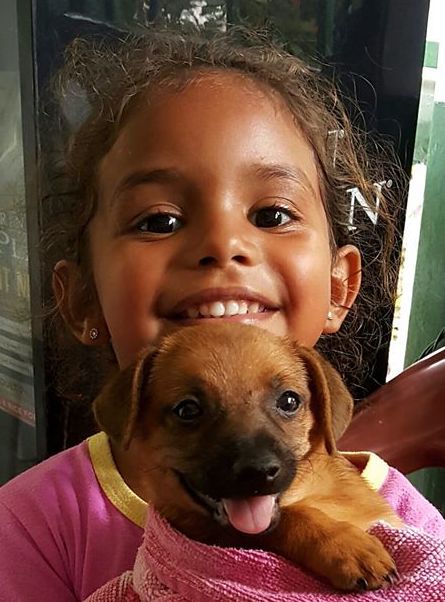
What pets are best for what kids, toddlers to teens? Most kids want a pet, but not all pets are appropriate for all children. How can parents keep kids and pets safe and happy? I asked pet professionals to share their stories and their suggestions about what pets they’d recommend for kids.
Dog trainer Abigail Witthauer worked with a family—three kids who wanted a pet and two parents who wanted the best for the pet and for their children. Abigail explains how it all turned out.
Abigail Witthauer (Alabama) I think it really depends on the family. I had a lovely client family who had the best plan I’ve seen yet. The kids (ages 6–12) were begging for a dog. The parents agreed that they could have one if they completed three months of a special chore chart without having to be asked.
Each child had age-appropriate chores that would be transferred to the dog. The older children had to take a 20-minute walk, rain or shine, every day after school. The younger child had to Swiffer®the house every day. The kids were told to wake up 15 minutes earlier than normal and pick up pine cones/sticks in the yard each day, and to make their own simple breakfasts (to simulate poop pick-up and feeding the dog). The children were also assigned age-appropriate dog behavior and training YouTube channels and books. They also met with us as a family during this time to learn about dog behavior and husbandry. Finally, the kids had to make a short presentation for the parents on what type of dog and characteristics they thought would be best for their family and why.
The kids completed all the tasks and got their puppy. While certainly the parents were still the main caregivers, the kids showed they were responsible and were rewarded.
In almost 20 years as a professional dog trainer, I’ve had this happen only once, but they were a completely lovely family and had a great relationship with their new family member!


Photo by Sara Maynard
Dogs and cats could be the first pets you’d think of, for children or adults. But your family might want to consider some “first pets” that don’t require such a big investment of time and money.
Here are some less traditional pets that might work well for children.
Rats
Lauren Fetterman (California) It depends on the kid, but in general, rats make great pets for kids. They tend to be the kid’s pet as opposed to the family’s pet. They are social, friendly, hang out on shoulders, can be litter-trained and trick-trained, and can learn their own names. They do best in pairs or groups, but one would be fine if the child spends hours a day with it. The only downfall is that they live only around two years.
Evee Linden (Connecticut) Pet rats. They are durable, love cuddles, and they’re easy to hang with. It’s like a dog in a small package. Rats tend to seek you out if they are out and about, loose. A lot of people have rats free roaming, as they can be litter-trained—but then you have to rat-proof. I’ve never had rats escape, though, not even when I left a door open. Rats are very homey type animals. The good/sad part is that if the kid gets tired of it, a rat only lasts one-and-a-half to two years.
Guinea Pigs
Alisha Ardiana (California) I had Guinea pigs in middle school. They are gentle, enjoy a variety of food, make fun noises, and they’re a wonderful introduction to caring for an animal. Added bonus: different breeds can have super cool hairstyles.
Mandy Collins (United Kingdom) Guinea pigs! They are trainable—an adored piggie will follow you around the garden. You can take them for walks in your doll’s pram, they have a range of noises that have different meanings, they look so darn cute when they eat! They can be housed indoors and out.
Guinea Pig Noises & What They Mean
Chickens
Frances Dauster (Alabama) Chickens!!! Easily trainable, scores of breeds and sizes, cheap to feed, cheap to purchase (get two or three, since they’re social creatures, usually around under three bucks apiece as babies), they sleep at night (unlike some rodents, etc.), they eat leftovers, and, if they’re hens, they lay eggs! They grow fast, have amazing personalities, their toes can be painted, they can wear a walking harness or a diaper. No rooster needed to get eggs, by the way. We have three veterinarians in our immediate area who treat chickens—one of them is actually a member of our chicken club. (Yes, chicken clubs are a thing.) Pet chickens can live indoors so the neighbors can’t complain! Take them to a park on-leash or a friend’s house to free-range some. I have a couple of chickens that are five-plus years old. They don’t lay anymore; they’re leftover-eaters.
Karen Jurasin (Washington) We had banty chickens when I was young. Eggs were a bonus. I held them and sang to them. We locked them up at night so the critters did not get them. No roosters allowed.
Hermit Crabs
April Shoe (Alabama) In a nutshell: My 12-year-old son came home from the beach with his father with a new friend—a hermit crab. It came in the travel case, a little bit of gravel, and a sponge. I wasn’t happy about it. My son’s father told me that it was harmless and would die soon anyway. That’s not how we roll in my household. I told my son that since he brought home a living creature, he would research proper care for the crab and he would earn the money it cost to provide that care.
He did a little research, then we were off to PetSmart to get the things we needed to set up the habitat—a 38-gallon aquarium, including gravel filler for the bottom.
A day or so later, we learned from a hashtag used on Instagram by a hermit-crab enthusiast that my son’s set-up was completely and utterly incorrect—and my son quickly made a new friend and mentor for this new endeavor. She told him that the crabs would die very soon if they weren’t able to dig deep into a sand substrate to molt their exoskeletons.
Back to the store we went to buy the actual proper substrate, heating pads, pools, etc. We learned that pet-store food wasn’t good for hermit crabs, so we started making fresh meals and ordering from a hermit-crab specialty food shop online. We also found out that sponges were no bueño.
My son then discovered that hermies prefer having friends to being alone, so we went to the pet store once more to buy two new friends.
We have had the most fun setting up their habitat with cool climbs, and learning what things are okay and what things are inappropriate for our crabbies.
They can apparently live 35 years in the proper set-up, so this will be an ongoing lesson for my kids.
Whether you choose the traditional cat or dog or a more unusual “first pet” for your children, you should know before you pick an animal what to expect throughout its life, however long or short that may be, and your children should know what to expect from you as you guide and supervise their relationship with that animal. It’s an adventure you should all enjoy!



